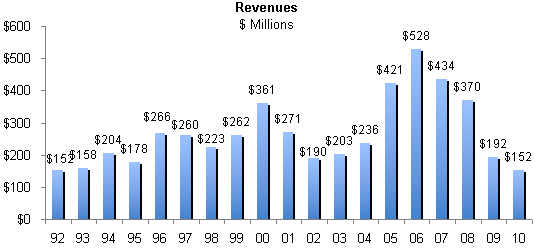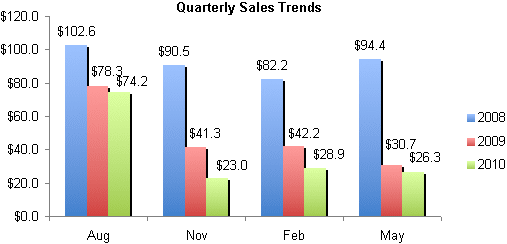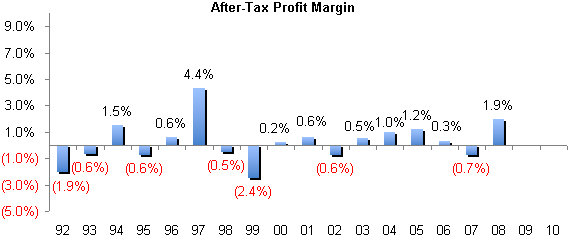IDEX Online Research: LKI Faces Tough Future
September 20, 10
(IDEX Online) - Lazare Kaplan International (LKI) is a shadow of its former self. The company recently reported that its revenues for the fiscal year ended May 2010 were just over $152 million, down from the prior year’s $192 million.
What the company didn’t say was how dramatically revenues have dropped since its peak year of 2006, when total revenues hit $528 million. Revenues for the most recent year fell more than 70 percent from 2006’s record level. Further, revenues were about the same level as in 1992 - $152 million.
The graph below summarizes LKI’s annual sales since 1992, the earliest data available in the IDEX Online Research database.
 Source: Lazare Kaplan International |
LKI generates its revenues from the sale of both rough diamonds and polished diamonds. More than a decade ago, a vast majority of its revenues came from rough diamond sales. Then in 2000 or so, the mix shifted to favor polished diamond sales. In 2005, the sales mix shifted again, with about two-thirds of revenues coming from the sale of rough diamonds, and the balance from polished diamonds. These mix shifts reflect new deals the company made with various diamond suppliers around the world.
Profits Elusive
Unfortunately, the company has been unable to report anything other than revenues for the past two years, causing it to lose its American Stock Exchange listing.
Why hasn’t the company been able to report anything other than total revenues? According to its legal filings, “The Company has been unable to resolve a material uncertainty concerning (a) the collectability and recovery of certain assets, and (b) the Company’s potential obligations under certain lines of credit and a guaranty.”
Worse, management says in its legal filings that 2010 was a year that will reflect substantial changes from the prior year, adding, “The Company, at this time, can only give a reasonable estimate of its anticipated net sales for Fiscal 2010.”
What’s left unsaid, however, is whether 2010 will be much worse than the prior year – which will likely reflect large one-time write-offs – or whether 2010 will be a “more normal” year without unusual charges.
Our Analysis: Large Operating Losses Likely
When analyzing a company, we typically eliminate one-time unusual events. We’re more interested to see how management is performing in the core business.
Based on our analysis of LKI’s long term historical trends – assuming a typical blended gross margin near 9-10 percent of revenues, with typical polished diamond gross margins in the mid-teen range and rough diamond gross margins in the low single-digit range – it would seem nearly impossible for the company to post a profit during any quarterly period since it last reported full financials – February 2009.
Historically, the company’s quarterly operating expenses are about $6-7 million. Assuming that the company was even able to generate a 10 percent gross margin during the recessionary environment, LKI would have come up $3-4 million short of profits – and cash – to cover its basic quarterly operating costs, prior to interest, depreciation, and other expenses. These calculations are based on quarterly sales ranging from $23 million to $29 million, as shown on the graph below.
The graph summarizes LKI’s quarterly revenues, as reported in its legal filings. Clearly, quarterly sales were solid in fiscal 2008 (12 months ended May 2008). Since then, quarterly revenues have fallen dramatically, though they appear to have begun to stabilize in the quarter ended May 2010.
 Source: Lazare Kaplan International |
LKI has always operated with thin net (after-tax) margins – typically in the low single-digit range. Those margins are so low that investors can’t really get excited about profit possibilities and investment returns. In normal times, investors would have been better off leaving their money in CDs than investing in LKI shares. The return on investment in LKI has been disappointing.
Based on historic profit ranges during periods of lower revenues, it is highly likely that the company will show significant operating losses in both fiscal 2009 and fiscal 2010.
The graph below summarizes net profit margins for LKI for the past two decades.

Source: Lazare Kaplan International
What Management Says About Its Results
In its legal filings, here’s how LKI management describes its current financial and operating situation:
“Although there are early signs of improving industry trends, current adverse conditions continue to impact the sectors of the diamond and jewelry industry in which the Company operates. Diamond and jewelry purchases are ultimately dependant on the availability of consumer discretionary spending. Uncertainties regarding future economic prospects and a decline in consumer confidence during Fiscal 2009 and Fiscal 2010 translated into lower purchases and sales by diamond retailers, wholesalers and producers and adversely impacted the Company's operations.
“In addition, the inability of the Company to timely resolve the Material Uncertainties has adversely impacted the Company’s ability to transact business in the ordinary course to the same extent and in the same manner as it did previously. This includes, without limitation, the ability of the Company to maintain and / or expand its operations.
“During Fiscal 2010, the Company continued to focus its efforts on cash flow while reducing operating costs and manufacturing overhead. Gross margins remained under significant pressure because of price competition, overhead absorption and inventory valuation considerations.
“The Company is not, at this time, in a position to give a reasonable estimate as to the Company’s gross margin and income before income taxes, among other results of operations.”
Shareholders’ Equity Likely In Jeopardy
One of the most important measures of value of a company is its book value – shareholders’ equity. Unfortunately, LKI doesn’t shine there, either. In the early 1990s, its shareholders’ equity was just over $90 million. It fell into the $70-80 million range around the end of the decade of the 1990s and early in the 2000s, but bounced back as the economy gained strength in 2002 and beyond.
Shareholders’ equity peaked around $96 million in 2005, and then began a slow erosion until 2008, when it bounced back just over $100 million for the quarter ended August 2008. The most recent level of shareholders’ equity was $94.5 million, reported for the quarter ended February 2009; that’s also the most recent quarter for any financial reports other than top-line sales.
There are rumors swirling around the industry about the potential size of the unusual charges which might affect LKI. Some of those rumors suggest that the company’s entire equity base could be wiped out, based on U.S. GAAP accounting.
For example, in May the company announced that it was suing its insurers for $640 million in damages. These damages were not described in detail. However, if there is a material discrepancy in accounting for assets of $640 million (unlikely, but not impossible), then the company would be technically bankrupt, unless it collects a substantial portion of its claim.
Shareholder Communications Minimal
Other than some filings with the Securities & Exchange Commission (SEC), some of which have been redacted as “confidential,” there have been no material communications with shareholders.
Further, the company’s board of directors amended its by-laws to allow a delay of its annual shareholders’ meeting. Thus, a shareholders’ meeting has not been held since late 2008.
Finally, the company recently announced that one of its directors resigned because of a potential conflict of interest. No one has been elected to fill that vacant position.
Conclusion: The Future Looks Challenging for LKI
With no financial data, a number of confidential SEC filings and virtually no communication from management, it is not possible to make reliable projections. However, even without complete financial data, we believe that the company has sounded the alarm in its legal filings.
Our conclusion: it doesn’t bode well for Lazare Kaplan.